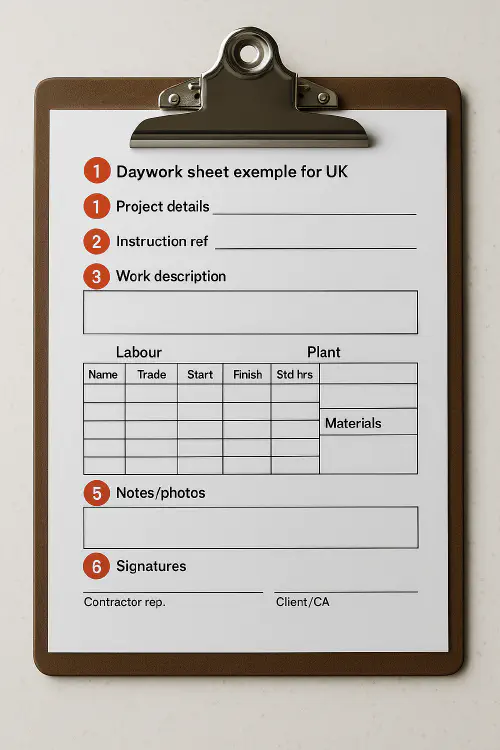
Daywork sheet template for construction: what to include, JCT sign-off and pricing
Daywork sheet template for construction: what to include, JCT sign-off and pricing
Category: Templates & Resources • Niche: Contracts admin, JCT dayworks, QS pricing

UK site foreman completing a daywork sheet with a 4-step flow overlay
Contents
- Quick answer
- When to use dayworks
- What to put on a daywork sheet
- JCT sign-off: who signs and when
- How the QS prices dayworks
- NEC equivalent to dayworks
- Template you can copy
- Worked tips to avoid rejection
- Video: dayworks explained
- Further reading and useful links
- FAQ
Quick answer
Dayworks are instructed tasks priced on actual labour, plant and materials plus agreed add-ons. Keep a simple, signed daywork sheet for each day and instruction. Include names and grades of operatives, exact hours, plant time, materials with references, and get the Client/CA signature the same day where possible. Under JCT, submit your daywork vouchers no later than the end of the week following the week the work was done.
When to use dayworks
Use dayworks when a variation can’t be fairly valued using contract rates, for example:
- Unforeseen obstructions or service diversions
- Emergency making-safe that can’t wait for pricing
- Small, incidental extras where measurement would cost more than the work
Helpful background: clear definitions and examples from Designing Buildings’ overview of dayworks in construction.
What to put on a daywork sheet
Include these fields so the QS can verify quickly:
- Project, address, main contractor, your company, date, location/area
- Instruction reference: AI/CVI/Site Instruction or Daywork Order number, who issued it and when
- Description of work and why daywork applies
- Labour table: each operative’s name, trade/grade, start/finish times, standard hours and overtime
- Plant table: item, size/capacity, on-site and working hours (and operator if relevant)
- Materials table: item, qty, unit, reference (delivery note/invoice)
- Photos/notes: brief photo log and any constraints (access, shutdowns, weather)
- Signatures: Contractor rep and Employer/CA rep, with names, roles, date/time
Designing Buildings’ guidance on recording dayworks is a good checklist.

Annotated UK daywork sheet example with numbered callouts for each section
JCT sign-off: who signs and when
- Who signs: On JCT Standard/Minor Works, the Architect/Contract Administrator (or someone they formally authorise). On JCT Design & Build, the Employer/Employer’s Agent signs.
- When: Submit daywork vouchers promptly—commonly no later than the end of the week following the week the work was done. Daily signatures on site keep things smooth, but the weekly deadline matters.
- What the signature means: It verifies the factual record (resources and hours). Entitlement and rates are still decided under the contract.
Useful practitioner explainers on daywork timing, verification and pricing:
- Streetwise Subbie’s guide to dayworks
- Ramskill Martin’s note on what daywork is and how it’s priced
Related Academy read: if your dayworks arise from a change, see our playbook on Variation order in construction: simple JCT procedure, pricing and templates that get paid.
How the QS prices dayworks
Most JCT contracts point to the RICS industry definition of “Prime Cost of Daywork.” There are two common setups:
- Prime cost plus percentages: labour, materials and plant at prime cost, then add the agreed percentage additions (covering overheads and profit). Percentages are in the Contract Particulars or BoQ.
- All-inclusive daywork rates: hourly all-in labour rates (with OHP built in), with materials and plant typically at cost plus agreed additions.
Clear intros here:
- RICS background via Isurv’s measurement downloads
- Legal overview of daywork rates on LexisNexis glossary
Practical tip: state overtime separately and only where ordered or agreed. Cross-reference your sheet to the exact instruction and area of work.
NEC equivalent to dayworks
NEC doesn’t use the traditional “daywork rates” approach. The nearest equivalent is valuing a compensation event at Defined Cost using the Short Schedule of Cost Components (Options A/B) or the full Schedule (Options C–F), then adding the Fee percentage. You still need the same level of daily records: people hours by category, plant time, materials, and subcontractor invoices. See NEC guidance on using the Schedule of Cost Components in your specific option.
Template you can copy
Copy these headings into your pad, Word or Excel, or build them into your site diary app:
- Project | Address | Main Contractor | Your company | Ticket no. | Date | Location
- Instruction: AI/CVI/SI no. | Issued by | Date/time
- Works description
- Labour: Name | Trade/Grade | Start | Finish | Std hrs | OT hrs
- Plant: Item | Size | Start | Finish | Working hrs | Operator
- Materials: Item | Qty | Unit | Ref/Delivery note
- Notes/photos
- Sign-off: Contractor rep name/sign/date | Employer/CA name/sign/date | Comments
If you prefer a pre-printed pad, UK suppliers like Oceanprint provide configurable daywork sheets. If you want a digital template, Sitemate has a free daywork sheet template.
Worked tips to avoid rejection
- Get written instruction or email confirmation before starting where possible.
- Aim for daily sign-off on site; always submit within the JCT weekly window.
- Separate standard time and overtime. Note constraints that affected productivity.
- Attach delivery notes, invoices and a few photos to reduce QS queries.
- Keep copies and email the QS with sheet numbers in the subject line.
Video: dayworks explained
A short explainer from Metroun Quantity Surveying.
Further reading and useful links
- Designing Buildings: Dayworks in construction and Recording dayworks
- Streetwise Subbie: Construction & Engineering Contracts Daywork – A Guide
- Ramskill Martin: Daywork – what it is and how it’s priced
- GOV.UK Contract Finder example appendix: Sample of contractor’s daywork sheet
- Academy: Pay less notice template: deadlines, wording and JCT examples
FAQ
What is a daywork sheet in construction?
A daywork sheet (or voucher) records the labour, plant and materials used on instructed work that can’t be fairly valued at contract rates. It should be signed by the Client/CA and submitted promptly.
How do you calculate a daywork rate?
Either use prime cost plus the contract’s percentage additions for OHP, or an agreed all-inclusive hourly rate that already includes OHP. Check your Contract Particulars/BoQ.
Does a signature guarantee payment?
No. The signature verifies the factual record. Entitlement and valuation follow the contract’s variation/daywork rules.
What’s the NEC equivalent to dayworks?
Under NEC, compensation events are valued at Defined Cost using the Short/Full Schedule of Cost Components, plus the Fee—supported by daily records.
What happens if the CA won’t sign?
Keep submitting timely, detailed sheets and escalate via the QS/contract procedure. A refusal to verify without reason can be challenged, but evidence is key.